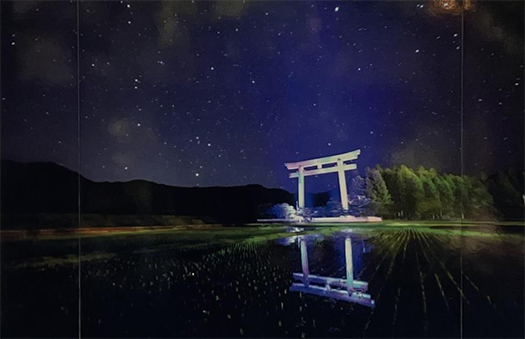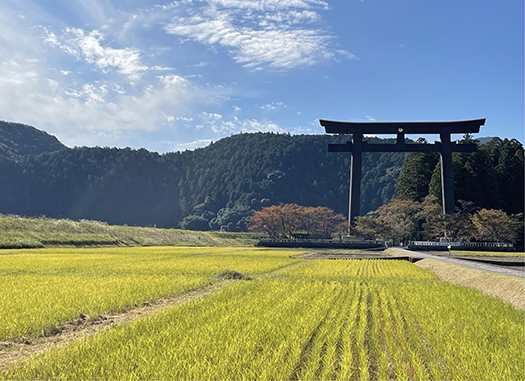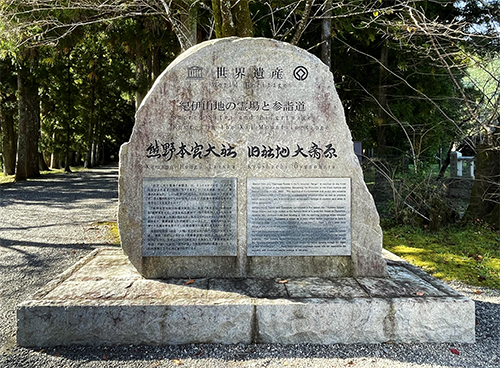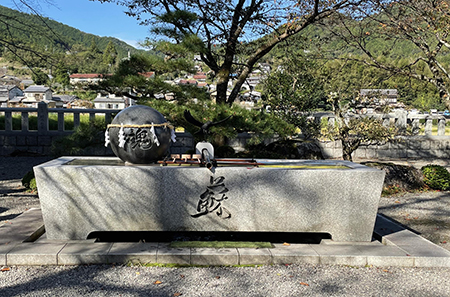

熊野三社という存在はそれを歴史などで学習する機会は現代ではほとんどないのではないだろう。
しかし自然神・山岳信仰の集約者ともいえる役行者。そして紀州の山岳地帯・高野山に本拠を持った空海などの日本精神史の重要人物たちは色濃く熊野を意識していたと思える。中世に於いては、念仏踊りの一遍もこの熊野本宮で回生の機縁を持ったとされるなど類例は無数にある。
そのように日本史の中で重要な「精神史」の基盤を為している存在であるのに、現代教育に於いては一顧だにされていないと思う。現にわたし自身もうっすらとその存在を認識していた程度で、それが日本精神史の重要な部分だとまでは考えが及んでいなかった。
中世以降、多くの皇統が熊野詣を繰り返し、また庶民も「伊勢に七度、熊野に三度」詣らなければよき人生と結縁できないという思いに駆られて大挙して参詣を繰り返していた、民衆のこころを固くグリップし続けてきていたこの重要な部分について触れることを避けてきているのだと思う。
たしかに歴史の正史という部分ではないだろうけれど、しかし人びとの内面を大きく規定したこうした側面について、正しい認識は不可欠ではないだろうか。
最近また増加傾向といわれる中国からの観光客の中国共産党独裁国家による「反日教育」の反映された悲しい言動を見聞きするにつれ、良識ある人間教育というものを考えさせられる。他山の石として、神国思想などではなく、本来の素朴な民族性について日本人はもっと知る必要があるだろう。



とくに熊野信仰のコア部分に「蘇り」というハートがあるということは、日本民族にとって非常に重要だと思える。火山列島であり、有史以来、大地震とかカルデラ級大噴火、大津波などの自然災害を繰り返し経験してきた日本。現に今、能登半島では地域の崩壊レベルの大災害に見舞われている。そのときに、粘り強く再生の努力を傾ける精神性は、こうした先人たちの知恵に大きく与っていると強く思う。悲しいことだけれど、135年前に十津川の地から北海道までの移住を決断して、みごとに民族の命の再生を見せてくれた先人たちの深い叡智に打たれていた。1889年当時は北海道の開拓という事柄はそれこそ民族の未来にとって土地の開発、ひいては殖民を通しての国防上の観点からも最重要であり、被災に際して国家的な「誘導策」もあっただろうことは想像できる。
しかし人びとにとって、母村を2,000kmも離れて原野を切り開こうと決意させた心底に、こうした熊野信仰が大きな心理的動因の一端にはなっていたと思える。
ながく日本人のこころに大きな存在であった熊野信仰のコアである、本宮旧社殿があった大斎原にわたし自身はこころを掴まれてしまった。まぁ、空間の磁力とでもいえるようなものでしょうか。
あした以降、そもそもの熊野信仰の祭神について触れていきたい。
English version⬇
The Root Idea of the “Rebirth” Power of the People Imperial Mythology and the Kumano Journey-14
Disaster-stricken islands repeatedly force their people to face difficulties. However, our ancestors have also bequeathed to us the faith to confront them. Passing on wisdom to the next generation. The wisdom of the past is passed on to the next generation.
The existence of the three Kumano shrines is something that few people today have the opportunity to learn about through history or other means.
However, the three Kumano shrines are the focus of the Kumano Sansha, or Kumano Gyoja, who can be said to be the central figure of nature gods and mountain worship. Kukai, who had his headquarters on Mt. Koya in the mountains of Kishu, and other important figures in the history of Japanese spirituality seem to have been deeply aware of Kumano. In the Middle Ages, the Nenbutsu (Buddhist prayer) dancer Ippen is said to have had a chance of rebirth at Kumano Hongu, and there are countless other similar examples.
As such, it is an important part of Japanese history that serves as the foundation of “spiritual history,” yet it is not given a second thought in modern education. In fact, I myself was only vaguely aware of its existence, but I had no idea that it was an important part of Japanese spiritual history.
Since the Middle Ages, many imperial families have made repeated pilgrimages to Kumano, and the common people, driven by the belief that they could not have a good life without making a pilgrimage to Ise seven times and Kumano three times, have also made repeated pilgrimages to Kumano in large numbers. It is true that this is not an authentic part of history.
Although it may not be an authentic part of history, I think it is essential to have a correct understanding of this aspect that has largely defined the inner life of the people.
As I see and hear the sad words and actions of the increasing number of Chinese tourists reflecting the “anti-Japanese education” of the Chinese Communist dictatorship, I am reminded of the importance of educating people with common sense. As a stone from the other side of the mountain, Japanese people need to learn more about their true, simple ethnicity, not about the idea of a divine nation.
In particular, the fact that the core of the Kumano faith has the heart of “resurrection” seems very important for the Japanese people. Being a volcanic island chain, Japan has repeatedly experienced natural disasters such as major earthquakes, caldera-level eruptions, and large tsunamis since the dawn of history. In fact, the Noto Peninsula is currently experiencing a catastrophe of the level of regional collapse. I strongly believe that Japan owes a great deal to the wisdom of its predecessors for its persistent efforts to rebuild at such times. It is sad to say, but I was struck by the deep wisdom of our ancestors who made the decision to migrate from Totsukawa to Hokkaido 135 years ago and showed us the revival of our people’s lives. It is imaginable that there must have been some national “guidance” in the aftermath of the disaster.
However, it is likely that the Kumano beliefs were a major psychological motivating factor in the people’s decision to move 2,000 kilometers away from their home village to clear the wilderness.
I myself was gripped by Osaibara, the core of the Kumano faith, which has been a major presence in the hearts of Japanese people for a long time, and where the old Hongu shrine was located. Well, I guess you could call it the magnetism of space.
From tomorrow onward, I would like to talk about the deities of Kumano faith.
Posted on 1月 16th, 2024 by 三木 奎吾
Filed under: 日本社会・文化研究







コメントを投稿
「※誹謗中傷や、悪意のある書き込み、営利目的などのコメントを防ぐために、投稿された全てのコメントは一時的に保留されますのでご了承ください。」
You must be logged in to post a comment.